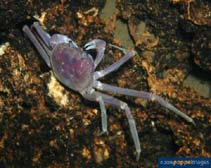| Family: |
Geryonidae (deepsea crabs) |
| Max. size: |
15.5 cm CL (male/unsexed); 17.7 cm CL (female); max.weight: 863.0 g |
| Environment: |
benthic; marine; depth range 130 - 2047 m |
| Distribution: |
Southeast Pacific and north Atlantic. |
| Diagnosis: |
|
| Biology: |
Maximum length for females from Ref. 2747. This is the largest epibenthic brachyuran crab of the Family Geryonidae (Ref. 2689). Bimodal length frequency for males and unimodal for females. More males and larger individuals in shallower substratum and increasing number of females and smaller individuals in deeper substratum (Ref. 2677, 2747). This is also a target species of gillnet operators in Northeast Atlantic fisheries (Ref. 2740). Inhabits a variety of bottom substrates from mud to rock (Ref. 2708, 2725 and 2747); at a depth of 700 m and deeper; it prefers soft substrata (Ref. 2753), and it is found on seamount and escarpments (Ref. 2740). Recruitment of individuals occurs in the deepest substrata. Sacculina sp. is parasitic on this species, infecting individuals in deeper substratum around 1000 to 1100 m (Ref. 2677). Males parasitized by Sacculina sp. are feminized behaviorally and morphologically (Ref. 2694), whereas females are castrated (Ref. 2696). Epibionts Poecilasma crassa and Poecilasma aurantia are found on the exoskeleton of the crab (Ref. 2747 and 2752). This is an allopatric species (Ref. 2763). |
| IUCN Red List Status: |
Not Evaluated (N.E.) Ref. 123251)
|
| Threat to humans: |
|
| Country info: |
|
Source and more info: www.sealifebase.org. For personal, classroom, and other internal use only. Not for publication.

